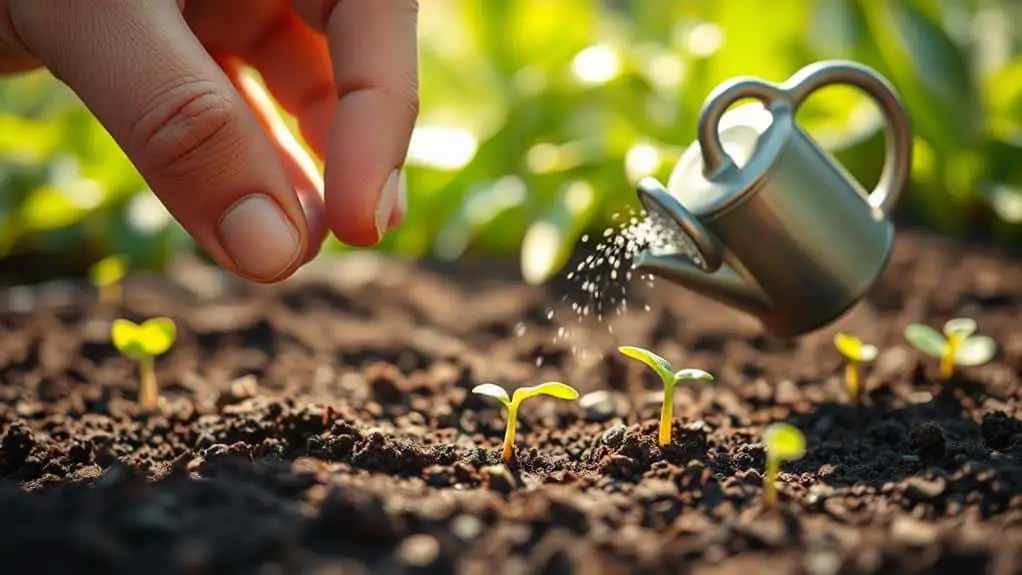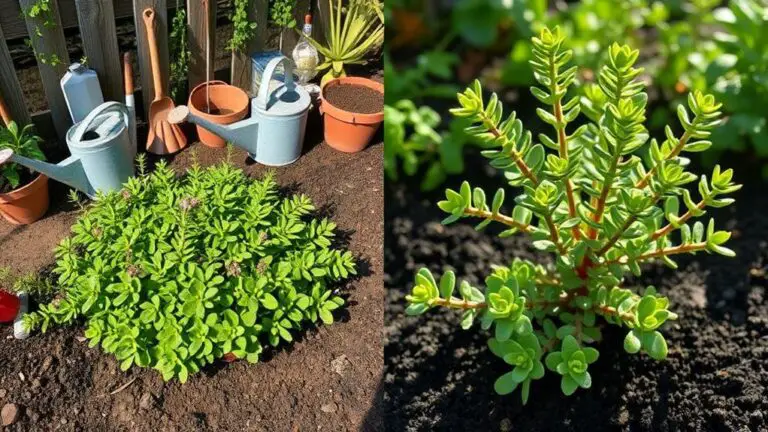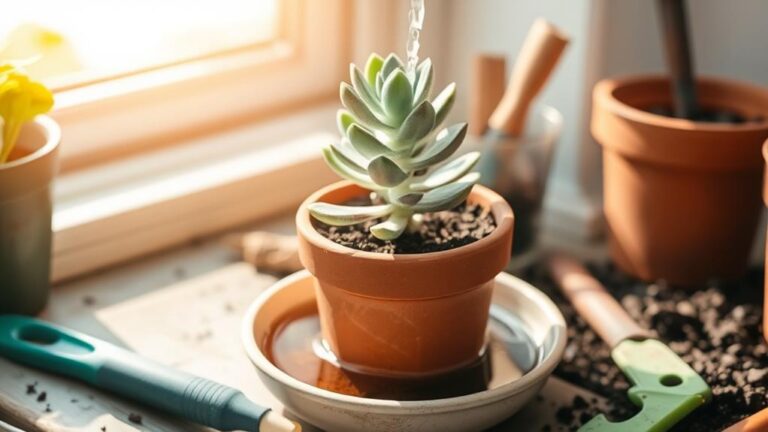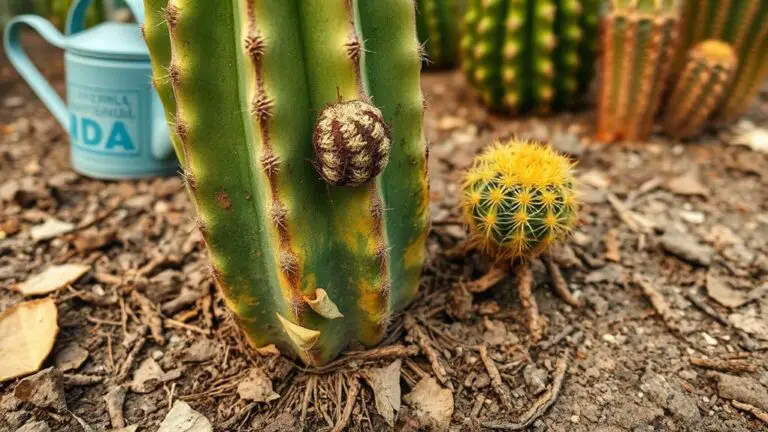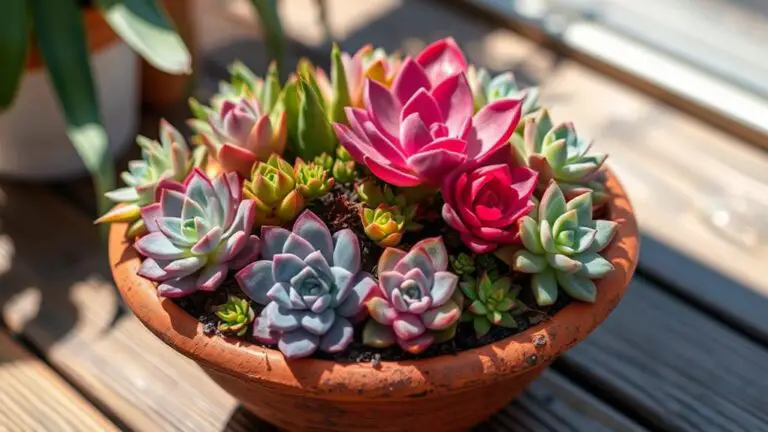How to Grow Succulent Seeds – A Step-by-Step Guide
If you've ever wondered about the benefits of growing succulents from seeds, you're not alone. It's a rewarding process that allows you to cultivate unique varieties right from their earliest stages. To get started, you'll need some basic materials and a bit of patience. Imagine watching tiny seeds transform into thriving plants that you can later repot or even gift to friends. But before you get to that point, there's a precise method to follow, beginning with a simple but vital step: soaking the seeds. So, what exactly comes next in this fascinating journey?
Benefits of Growing From Seeds

When you grow succulents from seeds, you gain access to a variety of rare and unique species that you mightn't find in stores, giving your collection a unique edge.
Growing succulents from seed isn't only exciting but also a cost-effective method. Seeds are usually much cheaper than purchasing mature plants, and one packet can yield several succulent seedlings, making it economical.
As you nurture these seedlings, you'll find the process incredibly rewarding. Watching tiny seeds transform into mature plants provides a fulfilling sense of accomplishment.
You'll get to see every stage of their growth, deepening your connection with the plants and enhancing your understanding of their growing conditions.
Additionally, propagating succulents from seeds allows you to share your success. With more plants than you might need, you can gift your healthy succulents to friends or fellow gardening enthusiasts, spreading joy and greenery.
This hands-on gardening experience is enriching. It teaches patience and offers insights into the life cycles of these resilient plants.
Gathering Necessary Materials

To start growing succulent seeds, you'll need to gather a few essential materials.
First, get high-quality seeds from a reputable source to guarantee they're right for the succulent species you want to grow.
Next, prepare a clean, shallow tray with drainage holes, a well-draining soil mix, a mister for gentle watering, and toothpicks for handling tiny seeds.
Essential Seed Sources
A bountiful collection of succulent seeds can set the stage for a thriving indoor garden. To get started, you'll need to source your seeds wisely. Local garden centers are a great place to find a variety of succulent seeds. They often offer fresh seeds which typically have better germination rates. You can also turn to reputable online stores for a wider selection.
Another fantastic option is community exchanges. You can swap seeds with fellow gardeners, which boosts variety and guarantees quality. If you're adventurous, you might harvest seeds from your existing succulents. Just make certain you properly identify the plants and check the legality of collecting seeds from wild sources.
Timing is significant. The best time to sow seeds is late winter to early spring. Some seeds require cleaning and drying before planting, while others benefit from pre-soaking or stratification to improve germination.
Don't forget to label your plants. Using plant labels to track species names and sowing dates helps keep your garden organized.
With these fundamental seed sources and a bit of preparation, you'll be well on your way to cultivating a diverse and healthy succulent collection.
Optimal Soil Mix
A suitable soil mix is vital for growing healthy succulent seeds. To achieve the best soil mix, start by creating a well-draining medium. Combine 2 parts loam-based seed sowing soil with 1 part grit or perlite and 1 part horticultural sand. This blend guarantees excellent drainage and aeration, essential for succulents.
Next, top your growing medium with a thin layer of horticultural sand. This step enhances moisture retention and helps prevent damping-off disease in your seedlings. It's a simple way to keep your young plants healthy.
Be sure to use pots with drainage holes. These holes let excess water escape, stopping root rot and keeping the soil's moisture levels balanced.
When filling your pots, leave about 1.5 inches of space between the soil surface and the pot rim. This space prevents overflow when you water your plants, making maintenance easier.
If you prefer a ready-made solution, consider a commercial cactus mix. These often contain ingredients like pumice or lava rock, promoting fast drainage and healthy root development.
Necessary Growing Tools**
When starting your succulent seed journey, gathering the right tools is vital for success. First, make sure you have high-quality succulent seeds from a reputable source. This will give you the best chance for good germination rates and healthy plants.
You'll also need shallow trays with drainage holes. These trays guarantee adequate air circulation and moisture retention, which are essential for your seedlings.
Next, prepare a well-draining growing medium. An ideal mix is 60% sand and 40% soil. This combination promotes healthy root development and prevents rot, which can be a common issue with succulents.
A mister for gentle watering is another must-have. It allows you to water your seedlings evenly without disturbing them. Succulent seeds are delicate, and a gentle misting helps keep the growing medium moist without washing away the seeds.
Don't forget to label pots with the species name and sowing date. This helps you keep track of what you've planted and when, making it easier to monitor growth and care for your succulents properly.
Germination Process
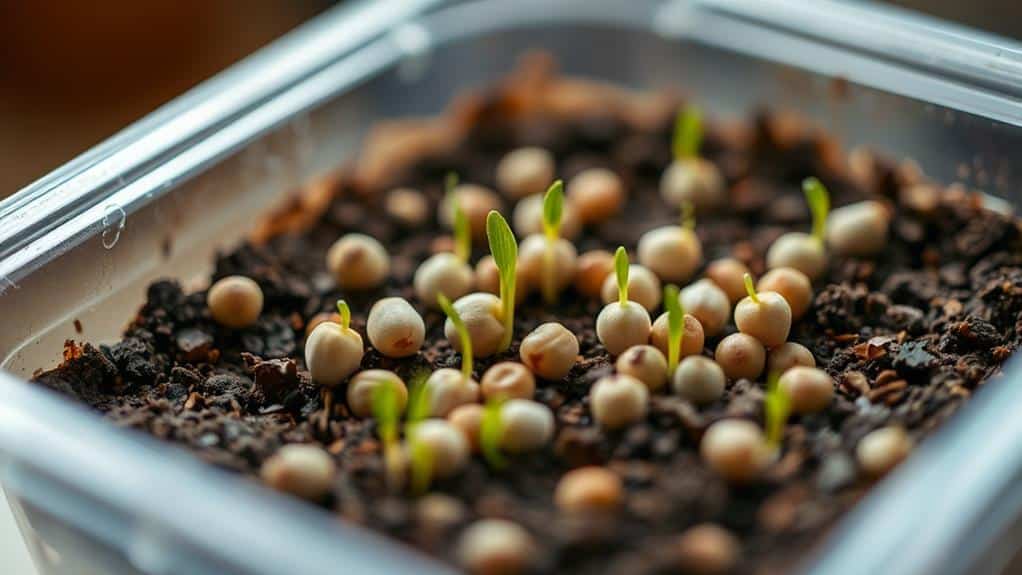
To kick off the germination process, start by soaking your succulent seeds in warm water for 12-24 hours to boost their chances of sprouting.
Next, prepare a shallow tray with a well-draining growing medium, keeping it moist but not too wet, and use a damp toothpick to place the seeds on the soil surface.
Keep the tray covered with plastic to maintain high humidity and a stable temperature between 65-80 degrees Fahrenheit until the seedlings appear.
Preparing the Seeds
Getting your succulent seeds ready for germination is an important step that can greatly influence their success. Start by soaking the seeds in warm water for 12-24 hours. This softens the seed coat and boosts germination rates. However, be cautious not to over-soak them, as this could lead to seed decomposition.
Next, prepare a clean, shallow tray and fill it with a well-draining growing medium. This is vital for succulents because they don't like to sit in water. Make certain the medium is moist but not waterlogged. This moisture level is ideal for the seeds to start their germination process.
Now, it's time to sow the seeds. Here's how you do it:
- Use a damp toothpick to carefully place the seeds on the soil surface.
- Don't cover the seeds, as some require light for germination.
- Maintain stable temperatures between 65-80 degrees Fahrenheit.
Cover the tray with plastic to create a greenhouse effect, guaranteeing high humidity. Once seedlings emerge, remove the cover to allow airflow. Keep an eye on moisture levels and gradually introduce the seedlings to sunlight.
These steps will give your succulent seeds the best start in life, setting the stage for healthy growth.
Planting and Care
Starting the germination process for succulent seeds requires attention to detail and a bit of patience.
Begin by soaking your succulent seeds in warm water for 12 to 24 hours. This step helps enhance germination rates without risking decomposition.
Next, prepare a shallow tray with a well-draining soil mix. Make certain the soil is moist but not waterlogged. Place the seeds on the surface of the soil without covering them. Succulent seeds need light to germinate.
Maintain stable temperatures between 65-80°F (18-27°C) and high humidity. You can create a greenhouse effect by covering the tray with a plastic cover. This helps keep the humidity high and the temperatures stable.
Once the seedlings appear, remove the cover to improve airflow. Gradually introduce them to sunlight, but be careful not to expose them to direct sunlight immediately.
The soil should remain moist, but avoid excess water to prevent mold. If you notice mold, replace the top layer of soil and guarantee proper humidity levels.
Using grow lights can also be helpful if natural sunlight is limited.
Just remember, consistent care and monitoring are key to successfully planting succulents from seeds. Happy planting!
Seedling Care
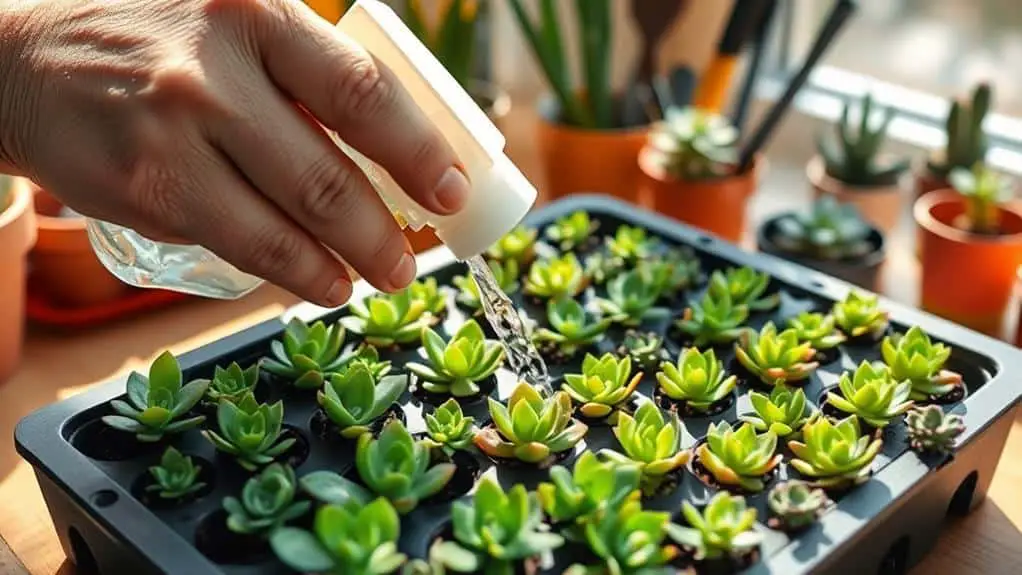
Nurturing your succulent seedlings is vital for their successful growth and establishment. Start by watering your seedlings sparingly. Allow the soil to dry out completely between watering sessions to prevent root rot, as overwatering is a common mistake among new growers.
High humidity during the early stages of growth is essential. Use plastic covers or humidity domes to create a greenhouse effect, which supports seedling establishment and encourages healthy growth.
To guarantee your seedlings acclimate to outdoor conditions, gradually expose them to indirect sunlight. Begin with short periods and increase the exposure time over several days to prevent sunburn. This step is important for building their resilience.
Fertilizing is another key aspect, but it should be done lightly. After a few weeks of growth, use a diluted, balanced fertilizer to provide essential nutrients. Avoid heavy feeding until the seedlings are well-established to prevent any potential damage.
Monitor your seedlings regularly for any signs of pests or diseases. Keeping a journal to track growth progress and care routines can promote healthy development.
Here's a simple checklist to help you:
- Water sparingly and guarantee soil dries out completely.
- Maintain high humidity with plastic covers or humidity domes.
- Gradually acclimate seedlings to indirect sunlight.
Post-Germination Growth
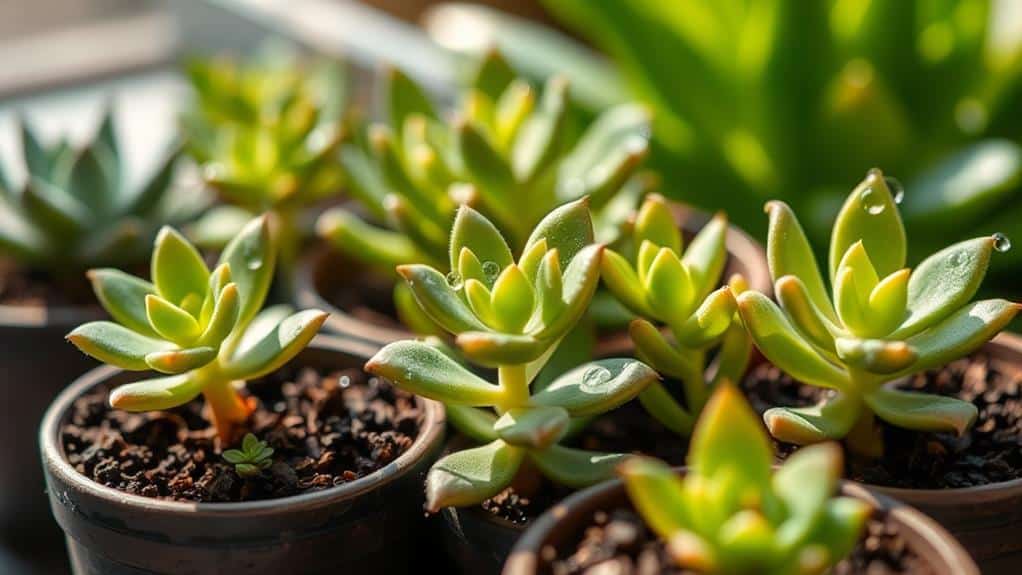
Once your succulent seeds have germinated, it's crucial to carefully manage their post-germination growth to guarantee they thrive. Keep the temperature between 65-80 degrees Fahrenheit to promote healthy growth of your seedlings.
After removing the humidity cover, start introducing them to sunlight gradually. Begin with a few hours of indirect sunlight and slowly increase the exposure over time to avoid shock.
Watch closely for any signs of mold on the soil surface due to high humidity. If you notice mold, replace the top layer of soil to prevent damping off, which can harm your seedlings.
When it comes to watering, be very sparing. Allow the soil to dry completely between waterings to avoid overwatering, which can stunt growth and cause root rot.
Patience is key; seedlings can take several months to become transplant-ready. During this time, provide consistent care and attention.
Keep an eye on their growth, ensuring they receive the right balance of water and sunlight. With the right conditions and a bit of patience, your succulent seedlings will grow strong and healthy, ready for the next steps in their journey.
Repotting and Gifting
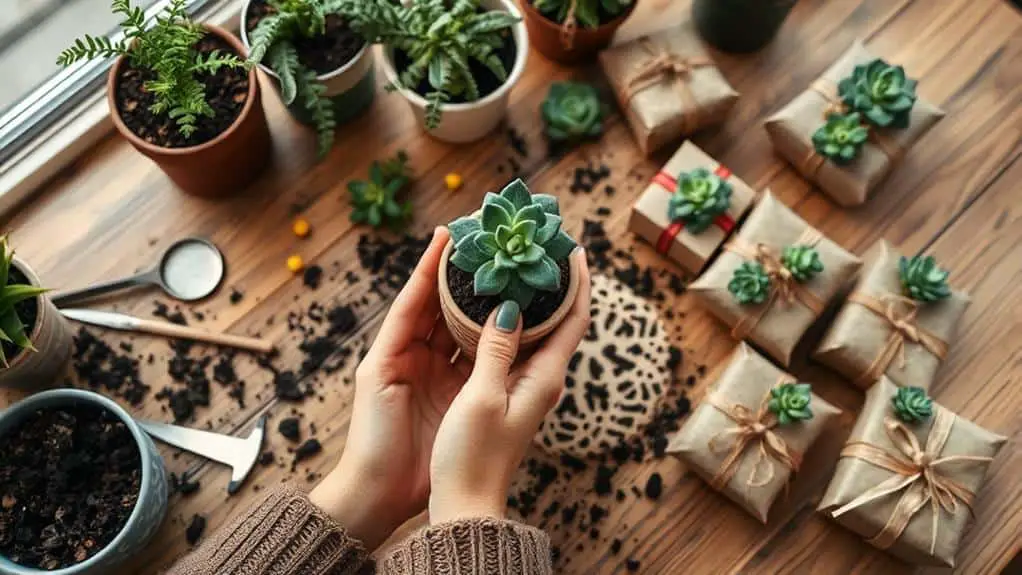
As your succulent seedlings mature, it's time to contemplate repotting them into individual pots to encourage healthy root development and avoid overcrowding.
Repotting your baby succulents is vital for their growth and overall health. When you move them to new pots, be certain to handle their roots gently to prevent damage. Choose pots with well-draining soil tailored to the specific succulent type to guarantee they thrive.
Here are three steps to guide you through the repotting process:
- Prepare the New Pots: Fill each pot with well-draining soil. Succulents need soil that doesn't retain too much moisture to grow healthy root systems.
- Gently Transfer Seedlings: Carefully remove each seedling from its current container, being cautious not to damage the delicate roots. Place them in the new pots and cover the roots with soil.
- Water Sparingly: After repotting, water the succulents lightly. Too much water can harm them, so let the soil dry out between waterings.
Once your succulents reach a presentable size, typically around 2-3 inches tall, consider gifting them.
Succulent gifts are thoughtful and customizable. You can select varieties that suit the recipient's preferences or create themed arrangements in decorative pots. Engaging with local gardening communities or online platforms can also offer opportunities to exchange or gift excess seedlings, fostering a sense of community and sharing.
Frequently Asked Questions
How Do You Grow Succulents for Beginners?
Start by getting quality seeds from reputable vendors. Use a well-draining soil mix and lightly press the seeds onto the moist surface. Keep them in a warm, humid area with indirect sunlight. Gradually acclimate seedlings to outdoor conditions.
How to Germinate a Succulent?
To germinate succulent seeds, soak them in warm water for 12-24 hours, then press them onto a well-draining mix. Keep temperatures between 65-80°F and maintain high humidity. Gradually introduce airflow and indirect sunlight once seedlings appear.
Conclusion
You've now got all the steps to grow succulent seeds successfully! Don't worry if it seems like a lot; just take it one step at a time. Start with soaking the seeds, then follow through with planting, caring, and eventually repotting. With patience and care, you'll soon see those adorable little succulents sprout. Remember, gardening is a journey, and every step you take brings you closer to a beautiful, thriving plant. You've got this!

